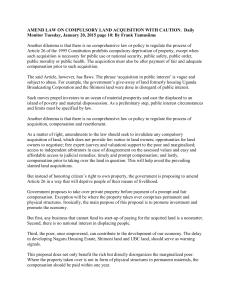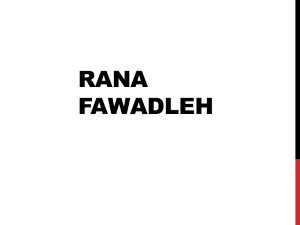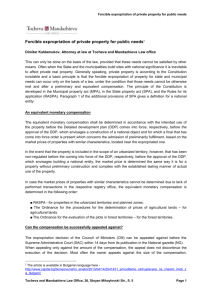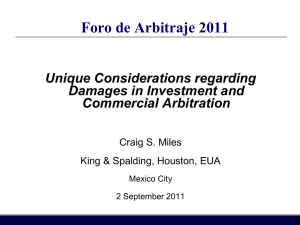Land Acquisition Policy Framework
advertisement
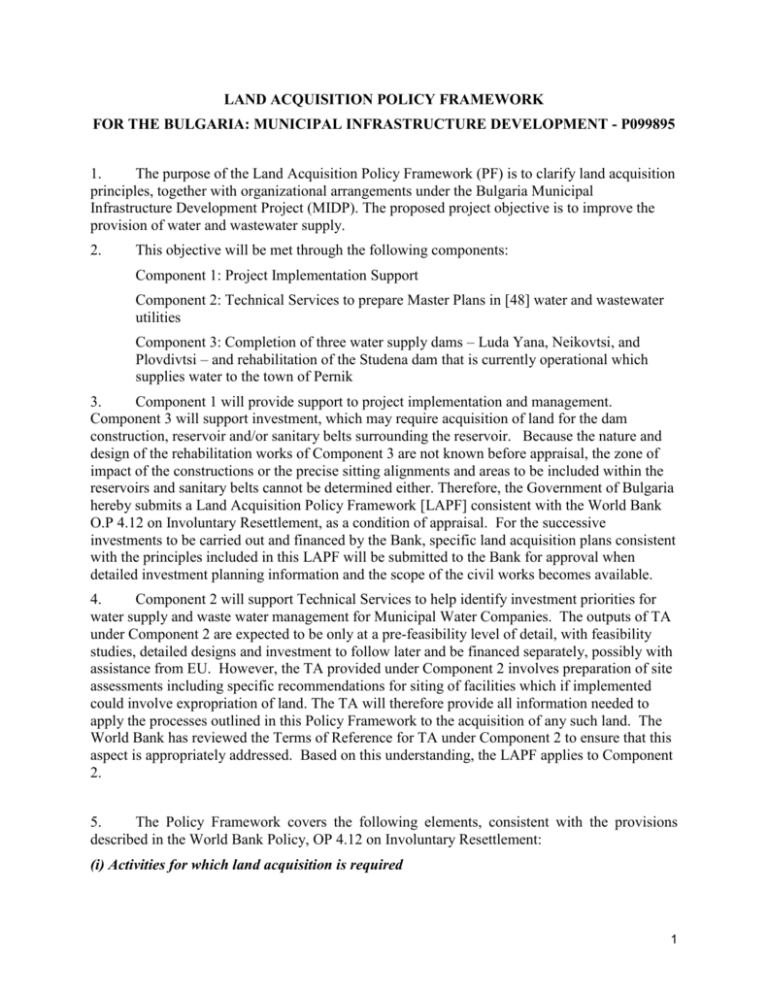
LAND ACQUISITION POLICY FRAMEWORK FOR THE BULGARIA: MUNICIPAL INFRASTRUCTURE DEVELOPMENT - P099895 1. The purpose of the Land Acquisition Policy Framework (PF) is to clarify land acquisition principles, together with organizational arrangements under the Bulgaria Municipal Infrastructure Development Project (MIDP). The proposed project objective is to improve the provision of water and wastewater supply. 2. This objective will be met through the following components: Component 1: Project Implementation Support Component 2: Technical Services to prepare Master Plans in [48] water and wastewater utilities Component 3: Completion of three water supply dams – Luda Yana, Neikovtsi, and Plovdivtsi – and rehabilitation of the Studena dam that is currently operational which supplies water to the town of Pernik 3. Component 1 will provide support to project implementation and management. Component 3 will support investment, which may require acquisition of land for the dam construction, reservoir and/or sanitary belts surrounding the reservoir. Because the nature and design of the rehabilitation works of Component 3 are not known before appraisal, the zone of impact of the constructions or the precise sitting alignments and areas to be included within the reservoirs and sanitary belts cannot be determined either. Therefore, the Government of Bulgaria hereby submits a Land Acquisition Policy Framework [LAPF] consistent with the World Bank O.P 4.12 on Involuntary Resettlement, as a condition of appraisal. For the successive investments to be carried out and financed by the Bank, specific land acquisition plans consistent with the principles included in this LAPF will be submitted to the Bank for approval when detailed investment planning information and the scope of the civil works becomes available. 4. Component 2 will support Technical Services to help identify investment priorities for water supply and waste water management for Municipal Water Companies. The outputs of TA under Component 2 are expected to be only at a pre-feasibility level of detail, with feasibility studies, detailed designs and investment to follow later and be financed separately, possibly with assistance from EU. However, the TA provided under Component 2 involves preparation of site assessments including specific recommendations for siting of facilities which if implemented could involve expropriation of land. The TA will therefore provide all information needed to apply the processes outlined in this Policy Framework to the acquisition of any such land. The World Bank has reviewed the Terms of Reference for TA under Component 2 to ensure that this aspect is appropriately addressed. Based on this understanding, the LAPF applies to Component 2. 5. The Policy Framework covers the following elements, consistent with the provisions described in the World Bank Policy, OP 4.12 on Involuntary Resettlement: (i) Activities for which land acquisition is required 1 (a) Expropriation of land 6. As indicated before, the design, siting, scope of the works and other details for the investments are not known in advance. The design for the specific investment will be determined during implementation. Land that has been or may in future need to be expropriated includes the site of the dams, their respective reservoir areas, and the area of the sanitary zones of Belt 1 (see below) where land use restrictions are sufficiently stringent that it has been determined these areas should become state property. The bulk of the land required for the main dam wall, dam lakes and corresponding submerged area, ancillary structures and adjacent infrastructure has previously been acquired by the Government of Bulgaria in the years 1978-1982, 1986, and 1998-2000. At the previous stage of construction designs for sanitary zones were prepared for Neikovtzi and Plovdivtzi dams and the lands within Belt I have also been expropriated. As the design for the sanitary zones at Luda Yana dam is yet to be prepared, at this stage it is not clear if additional lands should be expropriated. Considering, however, that the land expropriated for Luda Yana currently exceeds the projected size of the dam cup, and the fact that the reservoir is likely to be smaller than originally planned as the new design will no longer include provision for irrigation of 6,300 hectares, it is unlikely that additional expropriation will be needed. However, in the unlikely event that additional land is needed, expropriation will be done in accordance with the LAPF. The additional land acquisition supported under the Project is expected to be relatively minor, such as construction of ancillary structures including a water purification plant at Luda Yana dam,. Based on the available data it is not expected that any additional expropriation of land for will be required for Neikovtzi dam. 7. Any expropriation of land required for or directly linked to the dams will be carried out following well-established procedures specified in Bulgarian laws and procedures relating to land purchase and expropriation and World Bank Operational Policy (OP) 4.12 and Bank Procedures (BP) 4.12 on Involuntary Resettlement. Wherever Bulgarian Laws and World Bank policies are not in agreement, the principles agreed upon in the LAPF will be followed (as further specified in the following sections). However, the total value of compensation provided for any expropriation in any case should not be less than the amount which the individual or household would receive under the Government’s legal framework for land restitution and expropriation. It should be noted that no displacement of population is expected at any of the three sites. 8. According to the Agricultural land Ownership and Use Act 1991, and the Act Restoring Ownership on Forests and Forest Stock Land Tracts form the Forestry Fund, 1997, the last date for people to initiate claims for restitution of agricultural or forest land was May 14, 2007. Therefore, this LAPF does not include provisions for addressing new claims of ownership of land required for construction or operation of the three dams or is otherwise linked with the project. However, the LAPF does cover any cases in which the initial claim was made prior to this deadline and in accordance with the law, but which have not yet been resolved. This may include one known case in the vicinity of Plovdivtzi dam, concerning land which was claimed by the heirs of a Mr. Sinapov. There is one known case in which some land parcels were restituted to claimants under a court judgment and an expropriation process was initiated in 1998, but because the State failed to provide the details of the dam 2 project to be added to the map of restored properties, it was not possible to determine whether the land fell within the area required for the dam. If the detailed design indicates that any of this land falls within the reservoir or within SSA belts any expropriation that is required will be carried out in accordance with this LAPF. (see next section), (b) Restriction of land use or access 9. Under OP 4.12, restrictions on access to land or on use of land are regarded as a form of land acquisition. Bulgarian law provides for some restrictions of the activities within the sanitary zones, depending on their proximity to the dam site. The design and setting up of the sanitary zones shall be performed in accordance with the relevant Bulgarian law (Water Act, Public Health Act and Ordinance N 3 of 16.10.2000 on the Conditions and Procedures for studying, planning, approving and exploiting Sanitary and Protection Zones neighbouring water sources and drinking and household water supply facilities and mineral water sources used for treatment, prevention, drinking and hygiene purposes). As noted above, the strongest restrictions are imposed on the activities in the sanitary zones of belt I which should become public state property (expropriation). Land use and access restrictions in Belts II and III are more limited and are not considered equivalent to expropriation. Under this LAPF, such restrictions will be treated as loss of assets and income in the context of OP 4.12: i.e., the corresponding compensation amount at replacement cost will be determined based on a process of negotiation with the affected people and will be of a size sufficient to restore their livelihoods that are adversely affected. (ii) Principles and objectives governing land acquisition 10. For civil works associated with MIDP, it is likely that there is need for limited acquisition and this may result in the loss of land and perhaps the loss of sources of income. Loss of shelter is highly unlikely as people are not expected to lose their residences or other structures. 11. The premise governing the LAPF is that land acquisition may cause hardship and impoverishment, and therefore where it is not feasible to avoid land acquisition, project affected persons (PAPs) will consulted and compensated and assisted in their efforts to improve or restore their livelihoods and standards of living to levels prevailing prior to the beginning of project implementation. To support this objective, the following principles will apply: During the sub-project preparation process, consideration of technical options shall involve a concurrent assessment of potential associated land acquisition impacts, so that, where feasible, design alternatives to minimize such impacts can be identified as early as possible. Consultation arrangements during the project sub-component preparation process shall be transparent and inclusive to ensure that all persons affected by involuntary land acquisition are consulted on the mitigation measures. Compensation for lost assets shall be provided before land and other assets are taken into possession. (iii) Legal framework reviewing the fit between Bulgarian laws and regulations and World Bank OP 4.12 requirements, and measures proposed to bridge any gaps between them, and description of entitlements 3 12. Bulgaria does not have a single expropriation law. Rather there are several legislative acts governing the expropriation process. These laws and ordinances include the Law on Ownership, State Property Act, Municipal Property Act, Spatial Development Act, Code of Civil Procedure and Ordinance for the order of establishing prices of agricultural lands. These together define the procedures for expropriation of immovable property in Bulgaria. The expropriation of private properties is done only for a public interest and with fair compensation. 13. Prior to land acquisition, the investor submits proposals to the Committee on Agricultural Lands at the Ministry of Agriculture and Forests for approval of the design and likely change in land use. Simultaneously, licensed assessors begin the process of property evaluation to assess compensation amounts. The expropriation proposal is then submitted to the Minister of Finance and the Minister of Regional Development and Public Works, who jointly submit the proposal to the Council of Ministers (CoM). Simultaneously with the submission of the proposal for expropriation to the Council of Ministers, the copies of the expropriation proposal are mailed to the concerned Municipalities who announce it immediately. The Mayor of the respective Municipality also informs the potentially affected persons the proposal for expropriation. After the Council of Ministers decrees a decision on the proposal, appeals by interested owners are allowed to be submitted at the Supreme Administrative Court within 14 days after the publication of the information in the State Gazette. The investor of the project makes the payment of the compensation amounts into accounts of affected individuals at a commercial bank. The investor also announces the action in two national and one local newspaper. The Bulgarian procedures provide for information to the local governments and the people likely to be affected by a particular project. 14. Under the Project, in addition to the mailing of the expropriation proposal to the Mayor by the investor, the PIU will take supplemental measures to ensure that all affected people are notified in a timely way regarding their lands that are expected to be expropriated. In addition, under the Project, the Government of Bulgaria will allow appeals by interested owners to be submitted to the Supreme Administrative Court within 30 days after the Council of Ministers decrees a decision on the proposal. 15. The amount of compensation is determined with the help of qualified property assessment experts for urban and rural lands. For rural areas, where there is no active land market, the offer price for land is calculated based on a situation-specific formula that takes into account the market value of the affected property (as published by the MoA), and includes coefficients to improve the market price depending on the size and quality of the estate; existence of irrigation systems; distance from basic markets; distance from the coastal line of the Black sea or from the end of the beach strip; and the distance urban zones and bordering roads with permanent cover. The market value of the asset determined in conjunction with the State Property Act (STA) and paid as compensation to affected persons. The World Bank policy requires compensation for land to be at “replacement value,” enabling the affected person to purchase land of equivalent area and quality in the vicinity. Under the project, the Government of Bulgaria will appoint an independent valuator to review the Government’s valuation method and the resulting proposed offer prices for the first 15 expropriation cases to determine whether they correspond to this principle of “replacement value.” If this review indicates they do not, the valuation methodology applied to expropriation associated with the project will be revised to correct the discrepancy. 4 16. Loss of Income: It should also be noted that less than 10-20% of an individual’s land holding is expected to be adversely affected by the land acquisition process for the project – therefore, no significant loss of income is expected and impacts can be generally considered to be minor. However, if PAPs suffer loss of income through loss of more than 20% of their land holding, income restoration assistance will be provided if required, despite the fact that Bulgarian law does not call for this. This will take the form of “Rehabilitation Assistance” meaning assistance comprising job placement, job training, cash compensation, transition support or other forms of support to enable displaced persons, who have lost their source of livelihood as a result of the displacement, to improve or at least restore their income levels and standard of living to pre-project levels. 17. Loss of Structures: It is not expected that there will be any residential or other structures that will need to be acquired in the project site. However, in the event that there are structures (barns, kiosks, small commercial buildings etc.,) that will need to be demolished, “depreciation” will not be considered in calculating the compensation payable for affected structures. Although this differs from the provisions of Bulgarian law, the affected people will be compensated at a level enabling them to replace their structures." 18. Bans and Restrictions on Sanitary Zones: Under the legislation currently in force, belt І of Sanitary and Security Area around the dams comprises “the aquatic area from the dam wall up to a distance of 1000 m. from the water collecting facility against the stream, as well as a 50 m large strip from the boundary of the water site”. As mentioned elsewhere, these lands for belt I may need to be expropriated for the Luda Yana though it is not very likely, but not for Plovdivtzi or Neykovtzi sites as they have already been expropriated. The lands falling under belt ІІ and belt ІІІ are not subject to expropriation; however, some bans and restrictions on carrying out certain activities that are likely to have negative impacts on the water source, have been established. These include in the case of Neykovtzi, the managing of private animal farm, falling within the SSA belt ІІ; the managing of three chalets, falling within SSA belt ІІІ, creating new cemeteries etc,. According to data provided by the Municipality of Rudozem and Plovdivtzi county, the establishment of belt ІІ and belt ІІІ of Plovdivtzi Dam SSA will not result in bans or restrictions on activities. The restrictions in Luda Yana belts II and III are not yet known. The compensation for the expropriation of the lands in the innermost belt, Belt I, will be carried out as per the details set out in the Policy Framework .In Bulgaria, people adversely affected by land use restrictions in Belts II and III shall be compensated for loss of profits according to the procedures laid down by the Minister of the Regional Development and Public Works and the Minister of Environment and Waters; people who have restrictions imposed on farming and related activities shall be compensated according to a methodology for the evaluation of the compensation for lost profits deriving from restricted application of agrochemicals in the SSA, which shall be established by the Minister of Agriculture and Food Supply. Under this project, these restrictions on land use on Belts II and III on all dam sites will be treated as loss of assets and income triggering the Bank’s Policy on Involuntary Resettlement and the corresponding compensation amount at replacement cost will be determined based on a process of negotiation with the affected people and will be of a size sufficient to restore their livelihoods that are adversely affected. 5 19. Informal Land Use: During the field survey carried on 24, 25 and 26 October 2007 the following forms of informal use of the land in the dam sites have been identified: Luda Yana dam: during the whole year, except for the winter season, the dam site is used for grazing of approximately 50 cows, each of them owned by a separate household from the residential neighborhood of an individual in the Municipality of Panagiurishte. All the owners of the cattle have assigned the grazing to a single shepherd. The same households also use the dam site as a year-round pasture for their goats and sheep. The number of goats and sheep varies but during the period of most intense grazing it reaches 60 sheep (a single flock) and 60 goats distributed into 2 herds (one comprising 20 goats and the other – 40). The dam site is used by the cattle as a direct road to the municipal common designated for grazing and located in the area of Tarnov dol, which is not affected by the project. After the dam site is submerged, the cattle could be grazed at the above mentioned common but the road to it will be extended by approximately 500 meters. Approximately 46 000 000 m2 of pastures and commons are located at the territory of Panagiurishte Municipality, representing 18% of its entire agriculture fund. After the dam site is submerged, the cattle owners will have at their disposal other pastures and commons to meet the grazing needs. The Office of the Mayor of the Panagiurishte Municipality has confirmed that that after the dam site is submerged, the cattle owners will have at their disposal other pastures and commons to meet the grazing needs. See Attachment 1. Neikovtzi dam: the dam site is covered with construction materials and normally it is not used for agriculture purposes. As an exception, one of the local people uses the site for incidental grazing of his 4 sheep. Another local resident is grazing his 3 cows at a location approximately 1 km above the dam site. The relevant municipality has agreed that alternative land for grazing will be provided. See Attachment 2. Plovdivtzi dam: the dam site is used for grazing of 12 cows, 14 goats and 4 sheep, owned by a total of 10 households. The cows are normally immobilized in a barn and the hay mowed from the dam site is being brought to them. The mowing season covers the period from June to September-October. Normally the goats and sheep graze every day or every other day. Some of the interviewees said that a great part of the grass at the site is being mowed to restrict the risk of fire rather than for breeding purposes. Most of the cattle owners are not worried by the future submerging as they have enough land to support the grazing needs. One of the informal users, however, explicitly stated that he cannot continue to support his livestock (1 cow, 2 goats and 3 sheep) once the dam site is submerged. However, no information was provided as to why the alternative land that will be provided by the municipality cannot be used for the livestock. The relevant municipality has agreed that alternative land for grazing will be provided. See Attachment 3. 20. The informal use of land in the 3 dam site is limited to grazing. The involved households are using the cattle breeding as a support to their main source of income, but it is not their main form of livelihood. The shepherds of the herds and flocks at Luda Yana dam, for whom the grazing of cattle is their main profession, will have the opportunity to continue their activity even after the land is submerged as Panagiurishte Municipality have enough grazing zones. 6 21. While the World Bank OP 4.12 embodies the principle that a lack of legal land title does not disqualify people from resettlement assistance, under relevant Bulgarian legislation, discrepancies with this principle arise. However, as mentioned above, within the scope of this project, informal users of land without title or lease who use the land for temporary or seasonal purposes such as grazing will be entitled to alternative spaces for grazing. All informal users of land in the Sanitary Belts will also be entitled under the Project to rehabilitation assistance or some form of support to enable affected persons, who have lost their source of livelihood, to restore their income levels to pre-project levels. 22. However, the government wants to prevent false claims for assistance appearing after disclosure of project plans. Therefore, October 26, 2007 [the last date of the survey] has been chosen as a cut-off date after which any person carrying out illegal/ informal activities in the area is not eligible to receive any assistance as a result of project activities. This cut-off date is the date the consultants carried out the land-use survey to examine public lands allocated for the project for evidence of private use. Additionally, the Government has also a photographic file showing the current conditions in all three dams. (iv) Eligibility and entitlements 23. The following entitlement matrix describes the eligibility for compensation and/or assistance for impacts/losses for different types of assets and categories of project affected persons, applicable to the dam area and sanitary zones. Table 1: ENTITLEMENT MATRIX ASSET ACQUIRED ENTITLE TYPE OF IMPACT D PERSON AGRICULTU RAL LAND/ MEADOW LAND Less than 70% of land holding affected, The remaining land remains economically viable More than 70% of land holding affected and remaining land is not viable COMPENSATION ENTITLEMENT Cash compensation for affected land determined in conjunction with SPA such that it is equal to the replacement cost of the lost asset Rehabilitation assistance such as job placement, skills training and/or use of alternative land/property to re-establish use such as grazing Cash compensation for the assets at their replacement value plus Assistance comprising costs of shifting, allowance until first harvest, cash compensation, job placement, or job training, transition allowance etc,. Owner/title holder User of land without title Owner/title holder 7 ASSET ACQUIRED ENTITLE TYPE OF IMPACT D PERSON COMPENSATION ENTITLEMENT Rehabilitation assistance such as job placement, skills training and/or use of of alternative land/property to re-establish use such as grazing Cash compensation for entire structure and other fixed assets without depreciation Right to salvage materials without deduction from compensation Rehabilitation assistance if required (assistance with job placement, skills training) User of land without title BUILDINGS Entire structure affected STANDING CROPS Crops affected by land acquisition or temporary acquisition or easement Owner TREES Trees lost Owner TEMPORAR Y ACQUISITIO N Temporary acquisition Cash compensation equivalent to the market value for the affected crops Cash compensation based on type, age and productive value of affected trees Cash compensation for any assets affected (e.g. boundary wall demolished, trees removed) Owner LAND Bans and restrictions on activities in Sanitary Zones II and III Owner User of land without title Compensation for loss of assets at replacement cost Cash compensation for loss of income Rehabilitation assistance such as job placement, skills training and/or use of alternative land/property to re-establish use such as grazing (v) Mechanisms for consultations 24. In addition to documenting the expropriation procedures indicated above, once the scope of the civil works is identified, the concerned Municipality and other institutions will hold public consultations to discuss the expropriation and its implications, to which all land users whose lands will be affected by the expropriation will be invited. The PIU will also take the lead in ensuring that consultations are held with affected people and not entirely transfer the responsibility to the concerned Municipalities. The content and results of the consultation will be recorded in Minutes that are maintained in the sub-project files and made available to the Project Implementation Unit 8 PIU) and the Bank team. The Government of Bulgaria under the Project will supplement the expropriation notification procedure by extending the period of appeals regarding the compensation amount by affected people from 14 days to 30 days. (vi) Description of the implementation process and Arrangements for funding land acquisition 25. For civil works activity that requires land acquisition, a specific Resettlement/ Land Acquisition Action Plan will be prepared and submitted to the Bank for approval. The implementation of land acquisition activities will be linked to the implementation of the civil works to ensure that acquisition of land or other assets does not occur before the payment of compensation is made or other activities have been carried out. To repeat, land and related assets will be taken only after compensation has been paid. 26. The overall responsibility for expropriation for the Project is under the Bulgarian government represented by the Council of Ministers as well as the financial responsibility for expropriation. Allocation of relevant funds will be envisaged during budget preparation. The Minister of Finance and the Minister of Regional Development and Public Works are responsible for submitting of the expropriation documentation required by Bulgarian Law on expropriation. Following the budget preparation procedure, the MoF should envisage the necessary funds in the budget of Ministry of Regional Development and Public Works for expropriation procedure. 27. The decision for expropriation is taken by the Council of Ministers and the procedure is as follows: The proposal for expropriation is prepared by the Ministry of Regional Development and Public Works (MRDPW); The Minister of Finance and the Minister of Regional Development submit the proposal to the Council of Ministers, which decree a decision; The Decision Decree is published in the State Gazette. After that it can be appealed in the court. In case the decision decreed is not appealed in the court within the statutory time, it enters into force and can be implemented; Otherwise after the court passes judgment on the lodged complaint, the respective court order should be implemented. 28. The Minister of Regional Development and Public Works is responsible for following up and concluding of the expropriation procedures which include payment of compensation as well. The Minister of Finance in accordance to the Law follows up whether the request for expropriation is financially secured. The decision will also specify the authority that will bear the cost of the expropriation expenditures. MRDPW is responsible for the legal aspect of the expropriation request. The land acquisition transfer must be fully completed, and payment made, before any work can begin on the expropriated or acquired property. According to the Bulgarian legislation no civil works can start unless expropriation and compensation procedures have been completed. The land can be considered as expropriated from the moment of transfer of the compensation that is due to the affected parties. (vii) Responsible Institutions and/or Agencies 9 29. The key activities and responsible actors in the planning and implementation of the specific Land Acquisition Plan are outlined in the table below: LAND ACQUISITION ACTIVITY RESPONSIBLE AUTHORITY Assessment of Impacts & Inventory of Ministry of Regional Development Losses, including consultations and Public Works (MRDPW) and PIU Census of PAPs (socio-eco info), MRDPW and PIU including consultations Drafting the Land Acquisition Plan MRDPW and PIU Valuation of Assets MRDPW assigns to Licensed Independent valuation experts Consultations with PAPs MRDPW and the Mayor of the respective municipality and PIU Payment of Compensation and MRDPW Relocation Assistance (as cash transferred to Bank Accounts or in a public setting) Expropriation of land and assets Council of Ministers Monitoring and Evaluation MRDPW and PIU (viii) Grievance Redressal Mechanisms 30. The Expropriation Laws provide for an appeals process against the proposed award for compensation. The PIU staff also play an advisory and facilitating role in resolving grievances. Grievances related to land acquisition impacts should be pursued at the municipality/ community level with facilitation by PIU staff together with design consultants in order to find technical solutions that avoid or further minimize the need for land acquisition. Solutions to grievances related to compensation amounts, delays in compensation payments should be pursued directly by the designated authorities in liaison with the PIU staff who will inform PAPs about the avenues for grievance redress, and will maintain a record of grievances received, and the result of attempts to resolve them (Annex 1). This information will be entered into the Management Information System (MIS) and be included in the regular progress reporting. (ix) Process for preparing and approving Land Acquisition Plan and arrangements for monitoring 31. The PIU on the basis of completed and approved design including the Parcel Layout Plan for Land Acquisition will prepare a site-specific Land Acquisition Plan for all the expropriation required for the ancillary works in all 3 dams and/ or other activities and submit it for Bank review at least 6 months prior to commencing physical works. The Plan will include details about any prior steps taken, such as notification or consultation with owners, and description of the land acquisition process and mitigation measures. The Resettlement / Land Acquisition Plan will cover the following: 10 A census of persons affected by involuntary land acquisition including an inventory of lost assets and valuation of these, and socio-economic data. Description of the compensation to be provided Minutes of the public consultations with affected/persons Institutional responsibility for implementation and procedures for grievance redress Arrangements for monitoring and implementation A time-bound implementation plan and budget. 32. This will be submitted to the Bank for review and approval. The implementation of the Land Acquisition Plan will monitored by PIU as well as Bank supervision missions. The sources of funding for the different activities in the Land Acquisition Plan shall be clearly specified in the budget. The time-bound implementation plan will specify the delivery of land acquisition compensation and entitlements in relation to the timing of physical construction activities. 11 Annex 1 Reporting Format for Grievance Redress Name of Complainant Type of Grievance Affected, but not informed about impacts and options Compensation Compensation awarded is not paid inadequate1 before asset acquisition Grievance resolution Other Date of complaint Date resolved Pending Case referred to the Court Complainant A Complainant B Complainant C Complainant D Complainant E TOTAL 1 The column must be filled in as a result of effective decision of a court at law. 12 Annex 2 Reporting Format for Land Acquisition (Socio-Economic Data) Project name and location: _______________________________________________ ID # Name of PAP Gender Age Education Date: ________________________ Source of income (occupation / employment) Estimated total annual income (average of last 3 years) Estimated income 6 months after relocation Annex 3 Reporting Format for Land Acquisition (Inventory of Assets Lost, & Delivery of Compensation) 13 Project name and location: __________________________________ Date: __________________ Name of PAPs Inventory of Assets acquired through land acquisition and Compensation value of compensation awarded Agricultural Land <#% >#% CV 5 Buildings (Residences, Shops) Part ly Full y CV Other Assets Tree s Tem p. CV Total value of Date Of Com3 Date of Poss4 Comp2 /crop s 2 Total value of Com(pensation) = The total monetary value of compensation for different types of lost assets. 3 Date of Com(pensation) = The date on which the compensation payment was made to the PAP. Date of Poss(ession) = The date on which the assets acquired were physically taken into possession for the community project. CV = Compensation Value at replacement costs assessed in Levs. 4 5 14

